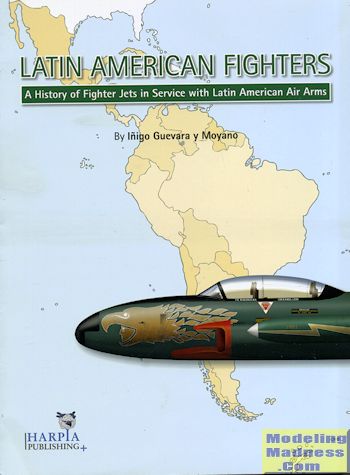 It
isn't very often that one finds a book on Latin American aviation. Though this
one is from 2009, much of what is in there is still quite valid. The author
covers each nation's air arm, concentrating on jet powered fighters. While some
countries were flying jets almost immediately after WWII, others took
considerably longer to finally join the jet age.
It
isn't very often that one finds a book on Latin American aviation. Though this
one is from 2009, much of what is in there is still quite valid. The author
covers each nation's air arm, concentrating on jet powered fighters. While some
countries were flying jets almost immediately after WWII, others took
considerably longer to finally join the jet age.
Many of these nations were recipients of the Military
Assistance Program (MAP) that was developed after WWII to help those nations
acquire the military equipment that they needed. The down side of this sort of
thing is that it is dependent on the whims of the US government so if someone
comes into power in a nation that the US does not like, then support is
withdrawn, basically turning the nation's equipment into static display. This
program also resulted in a nation not getting quite what it wanted, but what US
politicians thought it should have. All of this was to keep one nation from
getting more powerful than another and maintaining the balance.
A lot of Latin American nations had to go along with
this as they did not have the money required for state of the art military
equipment. Those that did, went elsewhere to procure equipment and so we see a
rather large influx of French aircraft as well as planes and parts and service
being provided by Israel. Some nations even went to the Soviets or Russians for
their equipment after being turned down by the US for more modern aircraft.
In the beginning, some nations relied on the UK for
planes while the majority started off their jet experience with T-33s and F-80s
to replace their WWII era piston powered fighters. The T-33s are now gone,
though many served for up to 45 years, to be replaced in many cases by A/OA-37
Dragonfly aircraft, planes that perform well in the COIN and light attack role.
The book is layed out by nation, starting with Argentina
and ending with Venezuela. Their jet procurement history is provided in the
order the planes entered service. In most cases, there are full color photos of
these planes and while some are museum examples, we are still provided a nice
look at their equipment. The time the planes were in service up to 2009 is
provided as well as the serials purchased and the codes provided to the planes
by the various nations. We are also provided with a look at any conflicts these
planes were involved in as well as a look at losses.
I have to say that I thought I knew a lot about the
subject, but was constantly surprised by information provided by the author. It
is pretty obvious that a lot of thought and research has gone into this one. A
nice surprise for me is that there is a list of kits and decals that have been
done up until the print time of the book.
Overall, it is an excellent read and a most welcome
addition to any enthusiasts book shelves.
April 2015
Review book courtesy of
Casemate Publishing, where you can order your copy
at this
link.
If you would like your product reviewed fairly and quickly, please
contact
me or see other details in the
Note to
Contributors.
 It
isn't very often that one finds a book on Latin American aviation. Though this
one is from 2009, much of what is in there is still quite valid. The author
covers each nation's air arm, concentrating on jet powered fighters. While some
countries were flying jets almost immediately after WWII, others took
considerably longer to finally join the jet age.
It
isn't very often that one finds a book on Latin American aviation. Though this
one is from 2009, much of what is in there is still quite valid. The author
covers each nation's air arm, concentrating on jet powered fighters. While some
countries were flying jets almost immediately after WWII, others took
considerably longer to finally join the jet age.